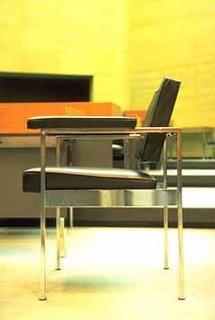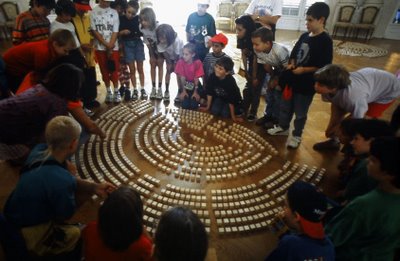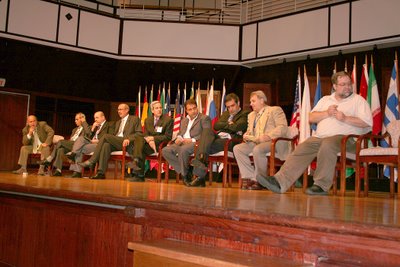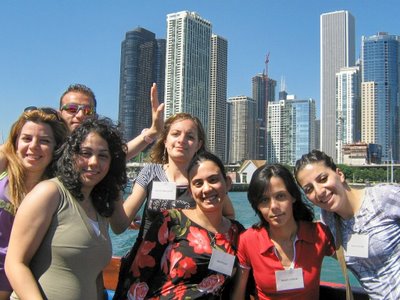Pierre Atlas has emerged as one of the most thoughtful voices on foreign affairs in Central Indiana. An assistant professor of political science at Marian College, Pierre is also director Marian's Franciscan Center for Global Studies. He also writes a bi-weekly opinion column for the Indianapolis Star and a monthly online column for RealClearPolitics.com. In May 2006, Pierre represented Marian College on a six-day trip to Cuba with members of the Archdiocese of Indianapolis and Catholic Relief Services; the group spent time in both Camaguey and Havana. The next month, Pierre was one of 22 American academics invited to pa rticipate in a two-week workshop on the Arab-Israeli conflict sponsored by Tel Aviv University. The group met with Israeli and Palestinian scholars, journalists and activists and traveled throughout Israel, including up to the Lebanese border where they saw Hizbollah flags flying on the other side. Two weeks after his return to the US, the Lebanon conflict erupted.On Wednesday September 20, Pierre will share his experiences at a talk for the Indiana council on World Affairs: “What I did on My Summer Vacation: Reflections on Cuba and Israel.” He will offer his analysis of both the current crisis in the Middle East and the potential challenges and opportunities of a post-Fidel Cuba. Provocate caught up with Pierre for a quick interview August 14th.
rticipate in a two-week workshop on the Arab-Israeli conflict sponsored by Tel Aviv University. The group met with Israeli and Palestinian scholars, journalists and activists and traveled throughout Israel, including up to the Lebanese border where they saw Hizbollah flags flying on the other side. Two weeks after his return to the US, the Lebanon conflict erupted.On Wednesday September 20, Pierre will share his experiences at a talk for the Indiana council on World Affairs: “What I did on My Summer Vacation: Reflections on Cuba and Israel.” He will offer his analysis of both the current crisis in the Middle East and the potential challenges and opportunities of a post-Fidel Cuba. Provocate caught up with Pierre for a quick interview August 14th.
Provocate: Tell us about your two trips. In the space of a few weeks you went to Cuba and to Northern Israel, right to the edge of Hezbollah-occupied Lebanon. Why were you sent on the trips? Had you made someone in the administration at Marian College angry?
Atlas:
The timing of the two trips was purely coincidental, but it made for an interesting summer, with Cuba in May and Israel in June. Both trips were amazing experiences, even life-changing. I knew I'd be going to Cuba at some point since last December, when I went to the
Catholic Relief Services HQ in Baltimore to discuss collaborations between CRS and Marian/FCGS. I met the Cuba desk guy, and he wanted me to go down there. I originally thought the Cuba trip would take place in April, but there was a lot of uncertainty with the visa process. And even when our May date was set, our "church visas" almost fell through at the last minute.
Here's what the Cuba trip was about. The Archdiocese of Indianapolis is the only archdiocese in the US that has a formal relationship with a counterpart in Cuba, the Archdiocese of Camaguey. I was asked to go on this trip (along with members of the Indy Archdiocese and CRS) to represent Marian College, and to see how Marian might help enhance the Indy-Cuba relationship given its position as the only Catholic college in central Indiana. Our group spent 3 days in Camaguey, and then took a 9 hour bus ride (through a monsoon) to Havana, where we spent our final 3 days. It was an incredibly exciting and very successful trip.
As for Israel, I was one of 22 academics at US institutions invited to participate in a 2-week workshop on the Arab-Israeli conflict, sponsored by Tel Aviv University, the first of its kind. We traveled all over Israel (including Tel Aviv area, Jerusalem, Haifa, Tiberias), meeting with and attending special seminars by Israeli and Palestinian scholars, journalists, security experts, etc. We met with Arab and Jewish Israelis, spent some time in the Druze community, got a tour of the security fence/wall, went up to the
Golan Heights, to
Sheba Farms and the Lebanese border.

Our US group was a very interesting mix of profs, with various national and religious backgrounds. All of us had academic expertise in some aspect of the Middle East broadly defined, and we arrived with different perspectives and opinions on the Israeli-Palestinian question. Despite--or perhaps because of--our diversity, we really bonded over the two weeks. We have kept in touch via email ever since we got back to the States, including during this crisis.
As a plug, let me note that on September 14, the first
FCGS Global Studies speaker for this year will be Dr.
Akram Khater, a Middle East historian, director of the Middle East studies program at North Carolina State University, and a native of Lebanon. He was one of the American participants in the Tel Aviv University workshop. I grew to really admire and respect him, and when the conflict with Hizbollah broke out, I had to invite him to Marian to speak on the subject. It was a no-brainer. His talk will be free and open to the public, 7 pm at Marian.
Provocate: Two weeks after you left Israel the Lebanon conflict erupted. A couple of months after you left Cuba, Fidel was hospitalized and passed authority to his brother Raul. A coincidence or do you perhaps have some other job we don't know about?
Atlas:
Funny, I noticed that pattern myself. Maybe I just leave excitement in my wake. It would have been interesting to be in those countries when these events broke out, but on the other hand, I'm glad I was home safe with my family.

Provocate:
What were the most surprising things you saw in Israel and Cuba? And why were they surprising?
Atlas:
This is one of the questions I plan to address in my ICWA talk on September 20 (another plug!). For Cuba, let me say briefly that some of the things I expected to see, I didn't, and I saw things that I really didn't anticipate. I expected to see pictures of Fidel everywhere, but I think I saw only one poster with his face on it in the entire 6 days. The ubiquitous image was Che Gevara, not Fidel. Che was on the facades of buildings, on posters, billboards, etc. And he was totally commercialized, with t-shirts and kitschy refrigerator magnets and key ch ains for sale everywhere. I found this humorously ironic, given the regime's communist ideology. What also surprised me was the absence of newsstands and "normal" book stores. It took a while for it to dawn on me, but you could not find an international newspaper or magazine anywhere, not even in the most expensive international hotel, the Hotel Nacional in Havana. The only books I saw were collections of communist propaganda for sale in the hotels and the official bookstores. The only American author I saw (in all the official stores) was Noam Chomsky. Another surprise was that there were no boats or even docks for small craft in Havana harbor. This is the first harbor I'd ever seen with no boats. I guess the government wanted to remove all temptation.
ains for sale everywhere. I found this humorously ironic, given the regime's communist ideology. What also surprised me was the absence of newsstands and "normal" book stores. It took a while for it to dawn on me, but you could not find an international newspaper or magazine anywhere, not even in the most expensive international hotel, the Hotel Nacional in Havana. The only books I saw were collections of communist propaganda for sale in the hotels and the official bookstores. The only American author I saw (in all the official stores) was Noam Chomsky. Another surprise was that there were no boats or even docks for small craft in Havana harbor. This is the first harbor I'd ever seen with no boats. I guess the government wanted to remove all temptation.
As for Israel, and I'll talk about this at ICWA, perhaps the most surprising thing is apparent in hindsight. We were at Kibbutz Misgav Am, right on the Lebanese border overlooking a Shi'ite village (I could see the Hizbollah flag flying on the other side), and we also went up to Sheba Farms, the disputed territory captured in 1967 that Hizbollah says belongs to Lebanon but that Israel (and the UN) says belongs to Syria. Our "tour guides" that day were an IDF spokesman and Eyal Zisser, a TAU prof who specializes in Syria and Lebanon. That was the day the solider was kidnapped in the raid from Gaza. Not only was there no sense of imminent danger on the Lebanese border, but the IDF was not on any combat footing whatsoever. I'll show some pictures at the ICWA talk that I took of the Sheba Farms checkpoint: just a few soldiers and a lone tank parked in a parking lot. Israel was not preparing for this war in advance, nor was it even thinking about war with Hizbollah. All focus was on Gaza. In fact, the IDF spokesman actually told us that units were being taken from the north and redeployed to Gaza for the pending operations there.

Provocate:
How were you received as an American by different groups in the two countries?
Atlas:
Ironically, I met more "ordinary" Cubans than I did "ordinary" Israelis. In Camaguey, which does not get the tourist traffic of Havana, very white guys with cameras were an unusual sight. Cubans would walk up to us on the street and ask us where we were from. When we'd say the States, invariably each person would rattle off the US cities where they had family members. They were all very friendly toward us, even when the security people were standing nearby (and they were everywhere). I often wondered if the people talking to us were government agents. I had no way of telling for sure, but I think most were just ordinary Cubans. On the other hand, as we discovered in one tense moment in the Camaguey bus station, some people whom we assumed were just Cubans waiting for the bus did turn out to be security agents who had been spying on us.

Provocate:
Sounds like you are saving the story about the bus-waiting spies for your ICWA talk. Smart move, I'd attend just to hear it. Did you see a lot of anti-US government or anti-Bush in Cuba?
Atlas:
The US interest section in Havana (officially part of the Swiss embassy) is a couple of blocks from the hotel we were staying at, and I walked over there along with some others from our group. The building has an electronic sign that posts messages critical of the Cuban regime (it wasn't on that day). To block the view of this "counterrevolutionary propaganda" from the road, the Cubans erected a series of extremely large flagpoles with black flags directly in front of the building. [see attached photos]. This is typical of the games the US and Cuban governments play, and if it wasn't for the fact that people's lives are in the balance, it really would all seem a bit silly.

Provocate:
In addition to the predictable insults to George W. Bush, political billboards in the pictures you brought back from Cuba showed a person who is probably unfamiliar to most Hoosiers (unless they are Cubans from Florida or Texas): Posada Carriles. Did your guides tell you anything about him?"
Atlas:
The boulevard was also lined with huge billboards denouncing Posada with rather graphic images, all facing the US interest section. This is what the Americans see as they look out their windows, and what drivers see as they drive by. As we were looking at the billboards, it took me a minute to remember who Posada was: an violently anti-Castro Cuban who allegedly plotted to blow up a Cuban airliner in the 1970s. He was in exile for years in South America, but then recently showed up in the US and requested asylum. His story got about 5 minutes of media attention in the US, but clearly he is a propaganda boon for the Cuban regime. They had a field day linking President Bush, who is waging a "war on terror," to a pro-US "terrorist." On one of the billboards, the regime seems to suggest that Posada is even worse than Hitler.
Provocate:
In one of your columns you describe a senior Fatah official briefing you about a "unity agreement" between Hamas and other Palestinian factions that were expected to jumpstart peace negotiations between the Israelis and Palestinians. But the next day, instead of reading in the newspapers about the breakthrough agreement you read about raids by Palestinian militants that kidnapped an Israeli soldier and provoked the Israeli incursions in the coming days. Do you think the actions by the Palestinian militants were deliberately timed to scuttle the "unity agreement"? Were the Israelis then mistaken to react the way they did?
Atlas:
I can't say with certainty that the timing of the Hamas attack from Gaza into Israel was related to the talks. But the attack was ordered by Khaled Meshal in Damascus (this was reported in the Israeli media and admitted by Meshal himself), who openly opposed Hamas PM Haniya's unity talks with Abu Mazen. So I doubt the timing was purely coincidental. But given these talks, I do believe that the IDF response played into the hands of the Hamas hardliners-as Israeli responses often do. The fighting in Gaza took the unity talks, which might have jumpstarted negotiations with Israel, off the agenda completely.
On the other hand, this was a deliberate attack from a tunnel dug under the (fully evacuated) Gaza strip, with the intent of capturing an Israeli soldier to ransom off. And the response was in the wake of hundreds of Qassam rockets fired from "liberated" Gaza into Israel. So the response was not just about the kidnapping of the one soldier. But with its responses, Israel is always in a "damned if you do, damned if you don't" position. If Israel responds with force, it might play into the hands of the militants; if it doesn't, then the militants might interpret Israeli inaction as weakness and carry on. Ultimately, the only way to resolve the conflict (for both sides) is through a political solution, not a military one.
Provocate:
What about the US embargo against Cuba? Is it achieving what it is intended to achieve (and what would that be)? What should be US policy toward Cuba these days?
Atlas:
I think the embargo is a disaster for the people of Cuba and also for US foreign policy. Rarely do you get such clear empirical evidence of policy failure as you get with the 40-year old embargo that has left Castro solidly in power. We give Fidel the ideal scapegoat that allows him to evade any responsibility for his regime's failures. He blames everything on the US, and the US is demonized on billboards across the country (and so is Bush, by the way). I think our policy toward Cuba should be a 180 degree reversal. We should be actively trading and dealing with Cuba the way we do with China.
 Provocate: Which do you think we will see first: a functioning and sovereign Palestinian state, a fully democratic Cuba, or peace between Israel and a Lebanon governed entirely by the government of Lebanon?
Provocate: Which do you think we will see first: a functioning and sovereign Palestinian state, a fully democratic Cuba, or peace between Israel and a Lebanon governed entirely by the government of Lebanon?
Atlas:
Gee, what a choice! I think all three are a long way off. I'd put my money on Lebanon first.
Provocate: What can we Hoosiers do to help the Cubans, the Lebanese, the Israelis, and the Palestinians?
Atlas:
One of the standard options is to "write your Congressman." Elected officials actually do care what constituents think. Beyond that, for Cuba, one of the strongest links Americans have is through their religious institutions, and here Hoosiers are ahead of the game. The Catholic Church supports very important (non-political) children's programs in Camaguey and puts together shipping containers of medical supplies (one of the few things the Cuban gov't will allow in). You can contact the Archdiocese of Indianapolis for details. Members of the Indiana Jewish community have gone down to Cuba on humanitarian missions to assist the 350 year old Cuban Jewish community. And I recently learned that the Methodist church in Indy is also involved in Cuba.
Major NGOs are actively involved in assisting Israelis, Lebanese, and Palestinians (usually not the same NGOs), and they are always willing to accept your donations. Catholic Relief Services is active in both Cuba and Lebanon. The UN World Food Program (directed by Hoosier Jim Morris) is active in the region too.
Provocate: How would you recommend we learn more about these crises (besides attending your talk at the Indiana Council on World Affairs on September 20th)?
Atlas:
Attend the events this year sponsored by the Franciscan Center for Global Studies at Marian! We'll address the Israel-Lebanon crisis on 14 September, and I hope to bring in the European Union ambassador to Cuba in the spring.
For current events, one of the best newspapers (and websites) in the Arab world is the English language Daily Star, published in Beirut (
www.dailystar.com). The best Israeli coverage (and one of the most reliable sources in the region) is the English language version of Haaretz, the Israeli daily (
www.haaretz.com). The English version of Al-Jazeera is also an essential source (
http://english.aljazeera.net/).


 Kenya is a good example. When the story is told some day of how Kenya survived the 21st century, its relation with Indiana will be an important chapter. You can learn about these Indiana-Kenya connections at Sagamore Institute January 26. The idea for this discussion began when the International Interfaith Initiative proposed sending a bus to Wright State University in Dayton to hear a talk by Kenyan Wangari Maathai on January 30. The choice of Maathai for Nobel Peace Prize in 2004 represents a new way of thinking about "peace" since Maathai's organization, the Green Belt Movement, encourages women's groups to plant trees to conserve the environment and improve quality of life ... worthy endeavours, but not within the scope that has been awarded Nobel Prizes in the past. Some Kenyans view the acclaim for Maathai with a bit of unease because her Movement's goals sometimes seem to give "Nature" priority over ordinary people's livelihood. (See the article by my Sagamore colleague Carole Kariuki.) Even more controversy over Maathai resulted when it became widely known that she believed AIDS was deliberately engineered to kill Africans. (She has since toned down this view.)
Kenya is a good example. When the story is told some day of how Kenya survived the 21st century, its relation with Indiana will be an important chapter. You can learn about these Indiana-Kenya connections at Sagamore Institute January 26. The idea for this discussion began when the International Interfaith Initiative proposed sending a bus to Wright State University in Dayton to hear a talk by Kenyan Wangari Maathai on January 30. The choice of Maathai for Nobel Peace Prize in 2004 represents a new way of thinking about "peace" since Maathai's organization, the Green Belt Movement, encourages women's groups to plant trees to conserve the environment and improve quality of life ... worthy endeavours, but not within the scope that has been awarded Nobel Prizes in the past. Some Kenyans view the acclaim for Maathai with a bit of unease because her Movement's goals sometimes seem to give "Nature" priority over ordinary people's livelihood. (See the article by my Sagamore colleague Carole Kariuki.) Even more controversy over Maathai resulted when it became widely known that she believed AIDS was deliberately engineered to kill Africans. (She has since toned down this view.)











 "
" Of course the piece of parchment that you will see at IMA isn’t really THE Constitution. Lokk past the funny "f" instead of "s" printing and read very first line of the document: “We, the People … have ordained and established this Constitution for the United States of America.” It wasn’t 57 individuals in the
Of course the piece of parchment that you will see at IMA isn’t really THE Constitution. Lokk past the funny "f" instead of "s" printing and read very first line of the document: “We, the People … have ordained and established this Constitution for the United States of America.” It wasn’t 57 individuals in the 

























